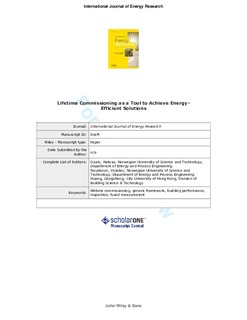Lifetime commissioning as a tool to achieve energy-efficient solutions
Journal article
Submitted version
Permanent lenke
http://hdl.handle.net/11250/2581587Utgivelsesdato
2012Metadata
Vis full innførselSamlinger
Sammendrag
Quality control of the complete energy system is necessary if energy-efficient solutions are to be met. To perform good building operation and quality control of a given system, it is necessary to have information about building systems and assessment tools. The paper presents Norwegian lifetime commissioning (LTC) procedures that are enabling follow-up of the building performance during the building lifetime by establishing a generic framework on building performance data. Further, three developed assessment tools are presented: inspection algorithm for ventilation system, mass balance inspection algorithm for consumer substation, and advanced method for improved measurement of heat pump performance based on data fusion technique. The LTC procedures were tested on two case buildings. The results showed that 20% of all the defined building performance data can be monitored by BEMS. Using the mass balance inspection algorithm, it was found that fault in mass balance prevented implantation of desired temperature control for floor heating system. For heat pump performance, measurement of differential water temperature can be very erroneous. Hence, use of compressor electrical signal can give more precise data on heat pump performance. Comparative analysis showed that detailed monitoring system helps tracking energy use and fault detection in operation. Yearly and hourly profiles of energy consumption with separated use and energy carriers are given in the paper. Copyright © 2011 John Wiley & Sons, Ltd
